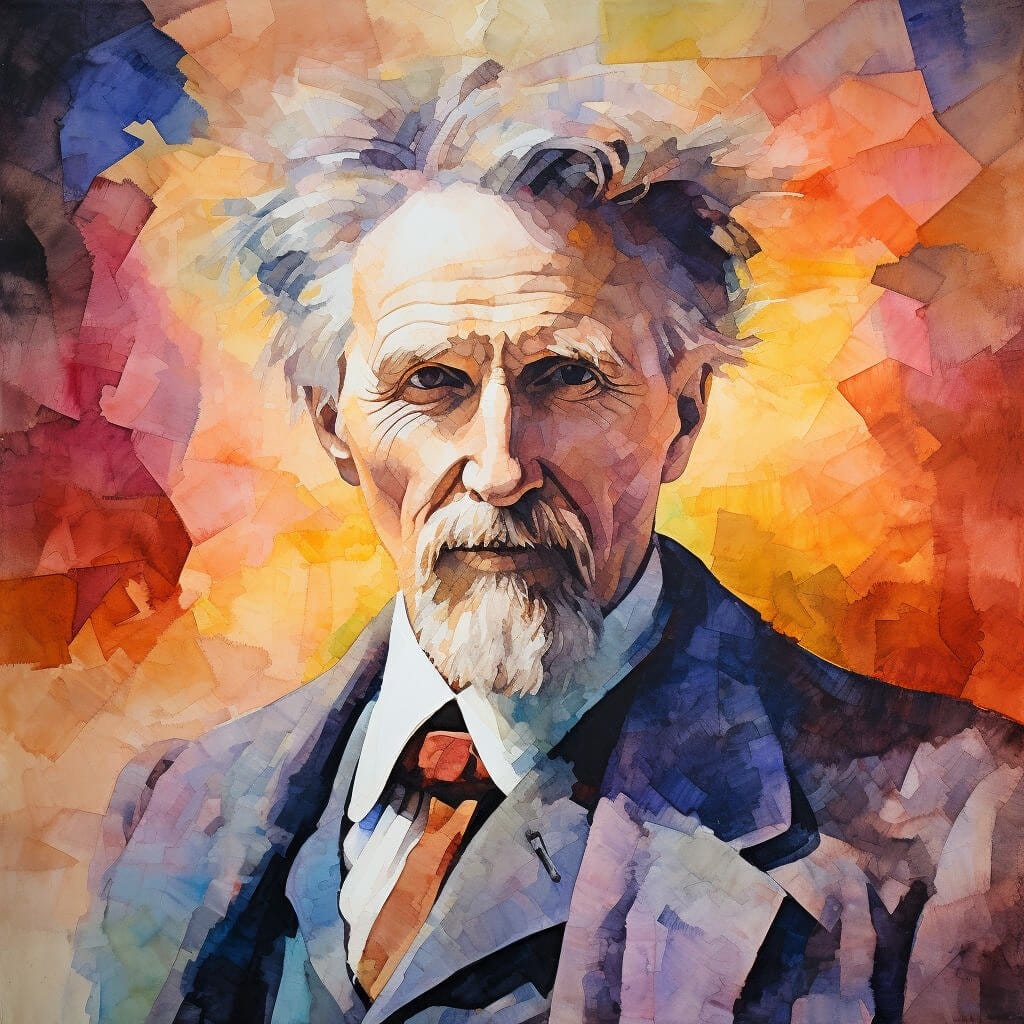Ezra Pound is considered to be one of the greatest poets of the modernist era. He is credited with the founding of the imagist movement. His work is known for its clarity, precision, and vibrantly clear images. He and other imagists chose to disregard form and the flowery language of the Victorian period, opting instead for a new style that, in some cases, said what was needed with as few words as possible. Despite the disparity between his style and classical poetry, he took a large influence from literary tradition.
Life Facts
- Ezra Pound was born in Hailey, Idaho, in October of 1885.
- In 1909 he married Dorothy Shakespear.
- He is considered to be the leader of the Imagist movement.
- Ezra Pound worked as a foreign editor of American literary magazines.
- Pound died in November of 1972 after a period of sickness, depression, and imprisonment.
Interesting Facts
- He was eleven when he published his first poem.
- Pound’s first book, ‘A Lume Spento,’ was self-published.
- He met and had a relationship with H.D. (Hilda Doolittle) at the University of Pennsylvania.
- Pound worked as a music reviewer during the early years of WWI.
- He was arrested in 1945 and confined to a mental hospital. Ernest Hemmingway and others campaigned for his release.
Famous Poems
- ‘In a Station at the Metro’ is the perfect poem to summarize the Imagist movement and what it represented. The poem is very likely the best-known of the period. It is only two lines long and was published in 1913 in Poetry. The lines describe a very brief moment on the metro in characteristic Ezra Pound style.
- ‘The Cantos‘ is one very long poem that is made up of 116 sections and is considered to be one of the landmark successes of the Modernist movement. It was written between 1915 and 1962 but never finished. Within the work, Pound explores familiar themes of culture, society, and economics. He uses Chinese characters and foreign languages.
- ‘The River Merchant’s Wife: A Letter’ is an interesting composition that takes the form of a letter from a wife to a husband. The young wife explores her relationship with her husband and how her feelings towards him have improved during the period they’ve been together. She was only fourteen when they married, but now she pines for him as he’s off selling his goods.
- ‘Hugh Selwyn Mauberley’ was published by Ezra Pound in 1920 and is one long piece that is made up of eighteen short poems. The poem contains autobiographical elements and, some scholars believe, an admission of the poet’s own failings.
- ‘The Return’ was written in 1913 and then published in The New Poetry: An Anthology in 1917. This unusual poem describes the return of a group of gods, “they,” who are coming back to earth. They are tentatively returning, unsure of what kind of strength they now possess or what the reaction will be. The poem concludes with the revelation that the gods are not what they used to be.
Explore more Ezra Pound poems.
Early Life
Ezra Pound was born in Hailey, Idaho, in October 1885 and grew up near Philadelphia. He was only eleven years old when he published his first piece. It appeared in the Jenkintown Times-Chronicle in 1896 and consisted of a limerick that described a failed presidential candidate. In the later years of the decade, Ezra Pound attended Cheltenham Military Academy. While at this institution, he spent a great deal of time studying Latin.
When Pound was thirteen years old, he traveled to Europe with his mother and aunt. They spent time in a number of different countries and then returned to America, where Pound went on to attend Cheltenham Township High School and, later, the University of Pennsylvania’s College of Liberal Arts. He met and started a romance with the now well-known writer, Hilda Doolittle, or as she is known now, H.D.
The following years saw Pound transfer to a school in Clinton, New York, graduating from the school in 1905. Pound then went on to study Romance languages at the University of Pennsylvania, at Hamilton College. He received his MA in 1906. In 1907 he began teaching at Wabash College in Crawfordsville, Indiana. it was from this point that Pound began to show an interest in Japanese and Chinese poetry. This influence guided a large majority of his creative decisions. The college dismissed Pound from its staff in 1908.
This turn of circumstances allowed the writer the opportunity to travel to Europe. Pound settled down in London, where he worked as a tour guide. Pound’s first book of poetry was self-published and appeared in July 1908. It was titled, A Lume Spento, or With Tapers Quenched. He would remain in London for the next twelve years. It was here that he reconnected with Hilda Doolittle.
Literary Career
In 1909 he married Dorothy Shakespear. She would go on to introduce her husband to W.B. Yeats— one of the writers that Pound respected most. The same year saw Pound publish Personae. It managed to bring in some financial success for the poet. It was followed by The Spirit of Romance which was his first book of literary criticism and was published in the United States. On his return to London, he was hired as the editor of the journal The New Age.
It was during this time period that Pound began to develop the style with which he is most closely associated, Imagism. The poet lived with Hilda Doolittle and her future husband, Richard Aldington, in a home in Kensington. The three are now credited as the founders of the movement. They were determined to craft a form of poetry that was concerned with language and presentation. It was created as a reaction to the complicated and overly-worded verse of Romanticism. Pound also began to contribute to Poetry magazine and Blast at this time.
During the early years of World War I, Pound worked as a music reviewer and published his collection, Cathay, and the first of his three cantos. He created the English version of early Chinese poetry, which was met with critical acclaim. The writer was deeply moved by the war and eventually sunk into a deep depression as the war took its toll on England and the rest of the world. In 1919 he published Instigation, a collection of essays that had previously appeared in The Little Review.
In 1920 he published Hugh Selwyn Mauberley, one of his most well-known poems. It spoke of the life of a poet whose days had taken on a feeling of uselessness. The following years saw Pound’s mental health suffer. The married couple was not fairing well, and Pound was engaging in a number of affairs. The two would separate soon after the birth of Pound’s daughter with Olga Rudge.
Later Life and Death
In the 1940s, Pound spent time as a radio broadcaster. He criticized the United States during World War II. He seemingly promoted fascist politics on a number of pro-fascist broadcasts, a move that ended in his indictment in absentia for treason. He was arrested in 1945 and was soon admitted to St. Elizabeth’s Hospital in Washington, D.C., due to his fragile mental state. At one point during his captivity, he was held in a six-by-six foot outdoor cage which was known as a “death cell,” as the authorities feared he would be freed from the prison by fascists. Pound was not released until April of 1958 after various campaigns on his behalf by other writers, such as Ernest Hemingway.
The poet’s writing career was over by this point as he was still suffering from depression and began to exhibit traits of dementia. He was admitted to a clinic in Merano, Italy. By the time Pound turned 87, he was very weak. Pound was admitted to a hospital in Venice and died in his sleep of an intestinal blockage.
Influence from other Poets
Ezra Pound was notably influenced by writers such as James Joyce, T.S. Eliot, William Butler Yeats, Walt Whitman, Robert Frost, and the poetry of Robert Browning.
FAQs
Ezra Pound is important to literature, as he is considered to be the founder of Imagist poetry and a pioneer of modernism. Imagism was concerned with the precision and economy of words whilst still portraying an image or a story. Pound was also instrumental in the rise of poets such as T.S. Eliot.
No, Ezra Pound did not win a Nobel Prize for Literature. Despite this, he was still a critically acclaimed writer, winning the Bollingen Prize for his work ‘The Pisan Cantos,’ published in 1948.
Ezra Pound’s writing style was everything that the Imagist movement was. There was an emphasis on the precision of language and sparseness. The goal was to portray an image with clarity and with the economy.
Ezra Pound found himself facing charges of treason in 1945. This occurred after he was accused of spreading fascist propaganda on his radio broadcasts.
During WWI, Ezra Pound was firmly against the war and surprised at how it escalated to such chaos. Unfortunately, a number of his friends, some poets, were killed in action.


